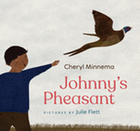
While driving home from the market, young Johnny asks his grandmother to pull over: he has spotted something by the side of the road. It turns out to be a pheasant; "Can I keep him?" he asks. Grandma is leery. She tells Johnny that she suspects that the bird has been struck by a car. Still, she acquiesces: "I can sure use his feathers for my craftwork." Johnny responds: "Hoot! Hoot!--the first of several such gleeful-goofy outbursts.
Once they've returned home, Johnny sets the pheasant in a box ("his bed until I gather sticks"). After the boy opens the door, the bird lets out a "Hoot! Hoot!" and flies outside. Johnny and Grandma follow and watch the pheasant soar. A lone feather drops at Johnny's feet. Clutching it, he runs around, imitating the bird. He finally stops before Grandma, and hands her the feather. Now she has a feather for her craftwork, the bird has its freedom, and Johnny has had an experience worth hooting about.
Johnny's Pheasant delivers a message--as Grandma says, "Pheasants belong in the wild"--with a feather-soft touch. Cheryl Minnema (Hungry Johnny), a member of the Mille Lacs Band of Ojibwe, drives her story with easygoing humor but not one superfluous word; Grandma's "Howah" is all that's needed to make clear that she and Johnny are Indigenous. Cree-Métis artist Julie Flett's (My Heart Fills with Happiness) sharp-edged geometric art, rendered in a subdued earthy palette, recalls the collage work of Ezra Jack Keats, although the enticing textures--bristly olive-colored grass, mottled floorboards with nailheads--are Flett's own. --Nell Beram, freelance writer and YA author

